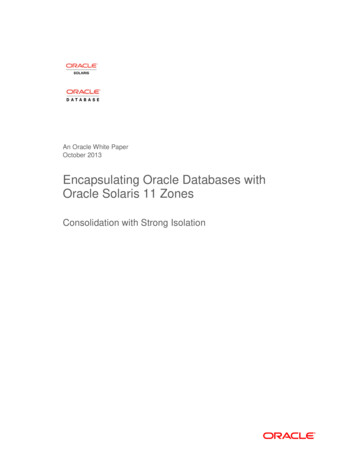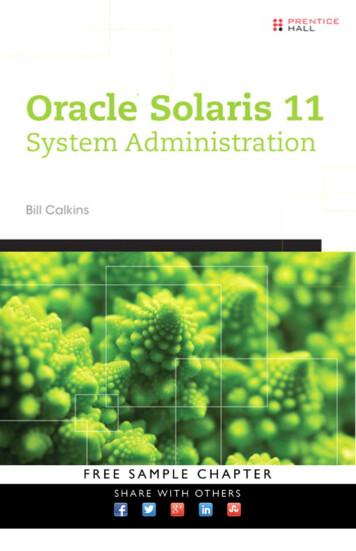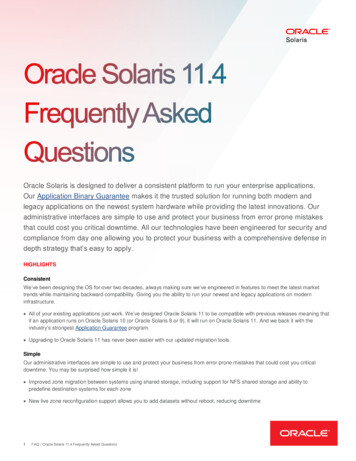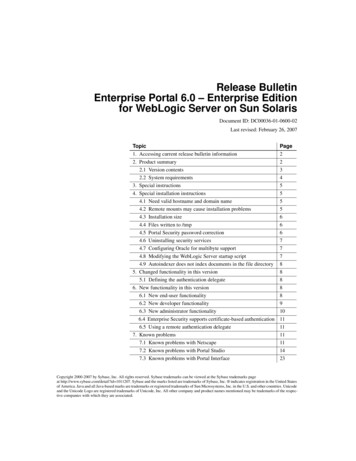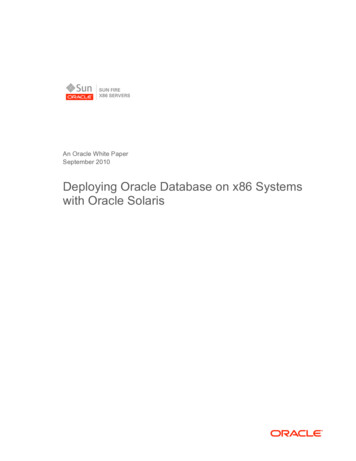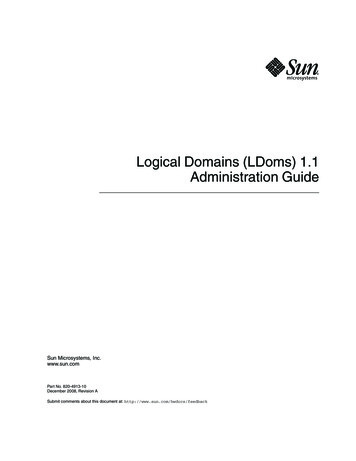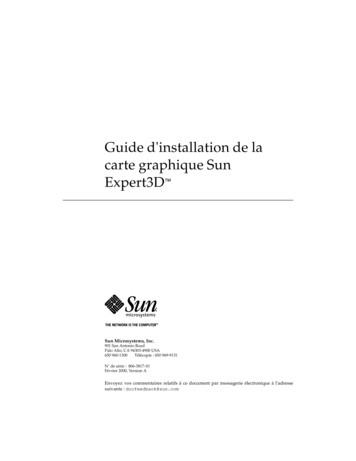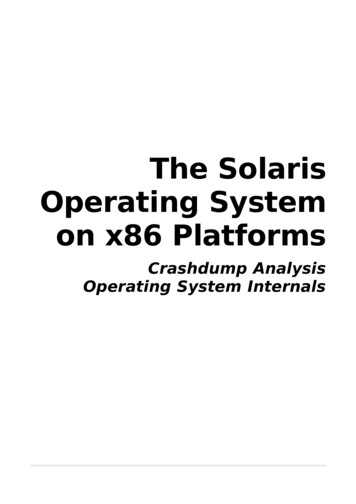
Transcription
The SolarisOperating Systemon x86 PlatformsCrashdump AnalysisOperating System Internals
Table of Contents1.Foreword.51.1.History of this document.51.2.About modifying this document.72.Introduction to x86 architectures.92.1.History and Evolution of the x86 architecture.92.2.Characteristics of x86.122.3.Marketeering – Naming the architecture.193.Assembly Language on x86 platforms.213.1.Generic Introduction to Assembly language.213.2.Assembly language on x86 platforms.253.3.x86 assembly on UNIX systems – calling conventions, ABI.323.4.Case study: Comparing x86 and SPARC assembly languages.423.5.The role of the stack.463.6.Odd things about the x86 instruction set.503.7.Examples of compiler-generated code on x86 platforms.513.8.Accessing data structures.653.9.Compiler help for debugging AMD64 code.734.Memory and Privilege Management on x86.774.1.The x86 protected mode – privilege management.784.2.Traps, Interrupts, System Calls, Contexts.894.3.Virtual Memory Management on x86.914.4.Advanced System Programming Techniques on x86.1015.Interrupt handling, Device Autoconfiguration.1035.1.Interrupt Handling and Interrupt Priority Management.1035.2.APIC and IOAPIC features.1046.Solaris/x86 architecture.1116.1.Kernel and user mode.1126.2.Entering the Solaris/x86 kernel.1136.3.Solaris/x86 VM architecture – x86 HAT layer.1186.4.Virtual Memory Layout.1216.5.Context switching.1226.6.Supporting Multiple CPUs.1246.7.isaexec – Creating 32/64bit-specific applications.1257.Solaris/x86 Crashdump Analysis.1277.1.Debugging tools for core-/crashdump analysis.1277.2.Troubleshooting system hangs on Solaris/x86.1297.3.32bit kernel crashdump analysis – a well-known example.1327.4.64bit kernel crashdump analysis – well known example.1507.5.Another 64bit crashdump analysis example.1637.6.AMD64 ABI – Backtracing without framepointers.1763
7.7.Examples on application coredump analysis on Solaris/x86.1777.8.Advanced Debugging Topics.1788.Lab Exercises.1798.1.Introduction to x86 assembly language.1798.2.Stacks and Stacktracing.1839.References.18510.License.1874
1.Foreword1.1.History of this documentThis document didn't start out from nowhere, but neither has it originally beenintended for publication in book form. But then, sometimes history takes unexpectedpaths .Shortly after Sun had revised the ill-begotten idea of “phasing out” Solaris for x86platforms and started to ramp up a hardware product line with Intel CPUs in it, I wasapproached by the Service division within Sun about where they could get anintroductory course about how to perform low-level troubleshooting – crashdumpanalysis – on the x86 platform. Information and trainings about troubleshooting on thislevel on SPARC platforms are widely available – starting with the famous “Panic!” bookall the way to extensive classes offered by Sun Educational Services to participantsboth internal and external to Sun. That notwithstanding, we soon found out that nointernal training about the low-level guts of Solaris/x86 did exist. Developmentengineers were usually both capable and encouraged to find out about the x86platform on their own, and users outside of the engineering space were few and farbetween. So this project started as a slide set for teaching engineers who were familiarwith SPARC assembly, Solaris Internals and some Crashdump Analysis thefundamentals of x86 assembly and Solaris on x86 platforms, strongly focusing on“what's similar” and “what's different” between the low-level Solaris kernel on SPARCand x86 platforms.I was to a large degree surprised by the amount of interest this material generatedinternally, so it grew, as time allowed, into a multi-day internal course on Solaris/x86internals and crashdump analysis. For a while, I came to spend a significant amount oftime teaching this never-official “class” .Then came the work on Solaris 10 and the AMD64 port. The new “64bit x86” platformsupport brought changes in the ABI with it that severely surprised even experienced“x86 old-timers” and required a large amount of addition to the existing material,which at that time had grown into a braindump of semi-related slides. Revamping theSolaris hardware interface layer for both 32bit and 64bit on x86/AMD64 as well as theaddition of new features like Dtrace or the Linux Application Environment madefurther modifications necessary.In the end, StarOffice's limited ability to deal with presentations of 200 slideseventually made it inevitable to drop the till-then adapted method of “add a slide as anew question comes up”.Would I have to make the same choice again I'd probably have opted to install myself aTeX system, but I decided to give StarOffice another chance and turn this material intosomething closer to a book. How I regret not having used TeX to start with . that'llteach me !Over the course of the AMD64 port of Solaris this grew into essentially the currentform, and when people started using the 64bit port internally a large amount of newquestions and typical problems came up which I attempted to address. To say itupfront, while the assembly language on AMD64 will be immediately familiar to peoplewho know about “classical” x86, the calling conventions used in 64bit machine code onAMD64 are so much different that in many aspects crashdump analysis onSolaris/AMD64 is closer to Solaris/SPARC than it is to Solaris/x86. But then it isn't .well, I'm disgressing, go read the book.Then the OpenSolaris project came. Initially, I had planned to publish this on launch1.Foreword5
day, but for many reasons this didn't work out at that time. So here it is – severalmonths delayed, no longer completely covering the state of our internal and external(OpenSolaris) development releases. But it's finally reviewed, the crashdump analysisexample dumps are made available, the StarOffice document has been cleaned up toonly rely on freely available fonts graphics.Which means that you – yes, look into the mirror – are now supposed to work with thismaterial, and on it. The whole document including all illustrations are now madeavailable in editable form.Please read the license attached to the end of the document. Yes, you can make modifications to this document. Yes, you can redistribute copies of this document in any form you see fit – you're infact encouraged to do so. Yes, you're encouraged to contribute corrections or additions.For all else legalese, see the appendix. 2003-2005, Frank Hofmann, Sun Microsystems, Inc.Enjoy – and never forget:Don't panic !(Shall I say green is my favourite color ?)If you wish to contact the author, please send Email to:Frank.Hofmann@sun.comAt this point in time, I cannot even start listing the number of people that have madethis document possible. Given that it didn't start as a book project I've kept a lousybibliography.I'd like to both thank every unnamed contributor as well as excuse myself for notnaming you.Using the words of Isaac Newton:“If I have seen further it is byStanding on the shoulder of giants.”You know who you are.61.Foreword
1.2.About modifying this documentStarOffice8 is used to edit this document, but (Beta) versions of OpenOffice 2.x shouldbe able to access it as well.The document uses the OpenSource DejaVu fonts which are a derivative of BitStreamVera. The difference between these two is that the DejaVu font family contains fullbold/italic/bolditalic/condensed typefaces for Sans, Serif and Monospaced, while theoriginal Bitstream Vera fonts only supply the full typeface set for Sans. Installing theDejaVu fonts is therefore a prerequisite to being able to edit this document andrecreate the output as-is.These fonts are available from http://dejavu.sourceforge.netOther fonts than DejaVu should not be used. To simplify this, switch the StarOfficestylist tools to only show “Applied Styles”, and don't use any but these.If you wish to contribute back changes/additions in plain text that's more thanwelcome. If you modify the StarOffice document itself, allow simple merge back byenabling the change recording facility in StarOffice. See the help functionality, on“Changes”.Note that StarOffice's master text facility is somewhat dumb – it records fullpathnames (instead of relative locations) for the subdocuments. When you openbook.odm in StarOffice8, the Navigator will show you the list of subdocuments. Use theright mousebutton to request the context menu, and choose “Edit Link” to change thepathnames of the subdocuments to refer to the location where you unpacked the fileset.The same is true for embedding graphics. Not even the documented functionality(“link” to the illustrations instead of instantiate a copy for the document) is working.So be aware when you change some file under figures/, you might need to delete andreinsert it in the main document .I'll keep a pointer to the current version (StarOffice for editing / PDF for reading andprinting) of this document on my blog:http://blogs.sun.com/ambiguous/And finally: These instructions should be better .1.Foreword7
2.Introduction to x86 architectures2.1.History and Evolution of the x86 architecture64bit256TB virtual memory16 registersAMD64 architectureintegrated FPUon-chip cache1993Pentium2003AMD OpteronSSE2 extensionRISC internally – µOps19852000Pentium 432biti803864GB RAM32bit MMUIA32 architectureIA32architectureSSE extension64GB RAM (PAE)on-chip 2nd lvl. cache1987i80486large pagesSMP support (APIC)MMX extension1997Pentium-II1999Pentium-III16 bit1978 1MB RAMi8086 8 Registers1982i80286still 16 bit16MB RAM8 Registersprotected modesegmentsIllustration 1 - Overview of the x86 architecture evolutionThe main driving force in development of the x86 processor family has always been toenhance existing functionality in such a way that full binary-level compatibility withprevious x86 processors can be maintained. How important this is to Intel is bestdescribed in Intel's own words:One of the most important achievements of the IA-32 architecture isthat the object code programs created for these processors startingin 1978 still execute on the latest processors in the IA-32architecture family.Among all CPU architectures still available in current machines, only the IBM3xxmainframe architecture (first introduced in 1964 with the IBM360, still available in theIBM zSeries mainframes) has a longer history of unbroken binary backwardcompatibility. All current “x86-compatible” CPUs still support and implement the fullfeature set of the original member of the x86 family, the Intel 8086 CPU which wasintroduced in 1978.This means: Executable programs from code originally written for the 8086 will rununmodified on any recent x86-compatible CPU such as Intel's Pentium-IV or AMD'sOpteron processor. Yes, MSDOS 1.0 is quite likely to run on the very latest andgreatest "PC-compatible", provided you can still find some single-sided 360kB 5¼"2.Introduction to x86 architectures9
floppy drive which would allow you to boot it on that shiny new AMD Opteronworkstation.Backward compatibility of the x86 processor family goes way beyond what most otherCPU architectures (including SPARC) have to offer. Sun Microsystem's Solaris/SPARCbinary compatibility guarantee only ensures that applications (not operating systemsor other low-level code) written on and for previous OS/hardware will continue to runon recent OS/hardware combinations, but it does not claim that old versions of theSolaris Operating Environment will run on processors that were yet unreleased at thetime a specific release shipped. This is different on x86. New versions of x86 CPUsfrom whatever vendor run older operating systems just fine. Incompatibilities if at allrise from the lack of device driver support for newer integrated peripherals, but notfrom the newer CPU's inability to function like its predecessors.Since introduction of the Intel i80386 in 1985 (!), most features of the x86 architecturehave remained remarkably constant. SMP support (via APIC) and support for morethan 4GB physical memory (via PAE) was added in the Pentium respectively to thePentiumPro processors; after that, only instruction set extensions (MMX, SSE) wereadded but no externally-visible changes were done to other core subsystems of x86.From the point of view of Solaris/x86, it was never necessary therefore to have morethan one kernel, /platform/i86pc/kernel/unix, for supporting the operating systemon x86 processors. Put this in context and compare it with Solaris in SPARC: For thevarious SPARC generations (maximum number of architectures concurrentlysupported in Solaris 2.6: sun4, sun4c, sun4d, sun4m, sun4u, sun4u1), each timeseparate platform support was required. Even today, Solaris 9 delivers ten (!) differentkernels for the various SPARC platforms, while Solaris 9 for x86 still has only one.This strict insistence on binary compatibility with its predecessors obviously hasdisadvantages as well. The way how the i80386 introduced 32bit support in some areaslooks illogical and counterintuitive, especially when comparing it with 32bitarchitectures that were designed for 32bit from their very beginnings. Some examplesof this will be given later.After releasing the i80386 32bit processor, Intel decided to keep future versions ofx86-compatible (“IA32” in Intel's terms) CPUs on 32bit. Each generation became fasterand added functionality, but the limitation to 32bit remained. In the early 1990s, thisdid not seem a problem because the major markets for x86 at that time (Microsoft DOSand Windows) were 16bit only anyway, and Intel's evolutionary path to 64bit had beenlayed out in the agreement with HP to co-develop a new 64bit architecture: IA64, thendubbed “Merced”, is today found in the Intel Itanium processors.But IA64 has nothing to do with x86. The instruction sets have nothing in common andexisting programs or operating systems written for 32bit x86 processors cannot run onmachines with IA64/Itanium processors in it. The Itanium, though produced by Intel, isa genetic child of HP's PA-RISC architecture, but only a distant relative to Intel's ownx86/IA32.In addition to that, Intel and HP were late at delivering the IA64 CPU – very late.So late that back in 2000, AMD stepped in and decided to extend the old x86architecture another time – to 64bit. AMD had, with varying success, been buildingx86-compatible processors since the early 1980s and saw Intel's de-facto terminationof x86 as a chance to extend its own market reach. The AMD64 (64bit x86)architecture was done in a way very similar to how Intel had done the i80386, andprocessors based on AMD64 (much unlike Itanium/IA64) are, in good old x86 tradition,fully binary backward compatible. Of course, actually using the new 64bit operatingmode requires porting operating system and applications (like using 32bit on the102.Introduction to x86 architectures
i80386 did require at the time). But even when running a 64bit operating system doesAMD64 provide a sandboxed 32bit environment to run existing applications in (again,like the i80386 which allowed the same for 16bit programs running on a 32bit OS).Therefore the AMD64 architecture offers much better investment protection than IA64– which will not run existing 32bit operating systems or applications.By the time the AMD Opteron 64bit processor became available, the Itanium, on themarket for three years then, had seen very little adoption – while users and softwarevendors kept pushing ever harder on Intel to follow AMD's lead and provide 64bitcapabilities in their x86 processor line as well. Intel resisted this for several years inorder not to jeopardize the market for their Itanium processors but eventually gave inand cloned AMD64. For obvious reasons Intel doesn't call their 64bit-capable x86processors “AMD64-compatible” but uses the term EM64T (Enhanced Memory 64bitTechnology) for the architecture and IA32e for the 64bit instruction set extension.Intel CPUs with EM64T are compatible to AMD64 – which Intel confirms in the FAQfor the 64bit Extension tensions/faq.htm notes that:Q9: Is it possible to write software that will run on Intel's processors withIntel EM64T, and AMD's 64-bit capable processors?A9: Yes, in most cases. Even though the hardware microarchitecture foreach company's processor is different, the operating system and softwareported to one processor will likely run on the other processor due to theclose similarity of the instruction set architectures.How the future of x86 will look remains to be seen. But the x86 architecture, withmore than 25 years of age, has far surpassed the success of all other (non-embedded)processor architectures ever developed. With 64bit extensions that have rejuvenatedx86, and x86-compatible processors with 64bit capabilities becoming commonplacenow, this is unlikely to change in the near future.2.Introduction to x86 architectures11
2.2.Characteristics of x86There are two factors responsible for the main characteristics of the machineinstruction set for what is commonly termed “x86 architecture”: The long history of x86 has left its mark on the instruction set.x86 machine code carries a huge legacy of (mis-)features from the time when thearchitecture was still 16bit only, and in parts even from pre-x86 8bit days (in theform of limited compatibility with the Intel 8008). The need to introduce new capabilities without breaking binary compatibility haslead to a lot of instruction set extensions that are optional, and whose presenceneeds to be detected by applications / operating systems that want to make use ofthem. In addition, x86 never was a vendor-locked-in architecture, even thoughIntel's decisions have dominated its evolution. Both operating systems andapplication code for x86 therefore needs to expend some efforts on determiningwhich CPU by what vendor it runs on, and what instruction set extensions this CPUprovides before it can make use of optimized code.This is fortunately much improved by AMD64 which establishes a new “64bit x86baseline”.In addition to that, x86 CPUs use the so-called little endian way of ordering data inmemory. Endianness becomes very relevant once data needs to be exchanged betweensystems of differing architecture.2.2.1.CISC and RISCBack in the early days of CPU design in the 1970s and early 1980s, manufacturingtechnology did not allow for anything close to the complexity we have today. CPUdesigners then had to make tradeoffs, mostly between a feature-rich assemblylanguage, but few registers and generally lower instruction throughput, and a featurepoor assembly language with many registers and faster execution for the simpleinstructions that there were.The x86 architecture is the classical example of a so-called CISC processor. The termCISC stands for Complex Instruction Set Computer, and is used to describe a processorwhose instruction set offers single, dedicated CPU instructions for possibly veryinvolved tasks. Philosophically, the ultimate design goal for a CISC processor is toachieve a 1:1 match between CPU instructions and instructions in a high-levelprogramming language.CISC is almost a requirement for CPUs which maintain full backward compatibilitysuch as the x86 family. Adding functionality to an existing architecture always meansadding instructions and complexity. A pure evolutionary CPU development as Intel hasdone it therefore almost necessitates a CISC architecture.All in all, Intel's latest instruction set reference needs two volumes and more than1000 pages to describe all x86 instructions supported by the latest x86 CPUs by Intel.For comparison - the sparcv9 architecture reference manual only has 106 pagesdescribing all sparcv9 assembly instructions.Given the focus on instruction functionality vs. versatility, CISC architectures tend tohave features like: 12many special-purpose instructions.An example on x86 would be two separate instructions for comparison – the genericCMP instruction and the TEST instruction which will only check for equality orzeroness.2.Introduction to x86 architectures
the ability to modify a memory location directly, without the need to load itscontents into a register first.This is done to offset the lack of registers – the idea is that if destination or sourceof an operation can be memory, less registers are needed. instructions with varying length.This is both due to the fact that CISC architectures usually allow to embed (large)constants into the instruction, and because feature additions over time haverequired the introduction of longer opcodes (instruction encodings).Another consequence of this is that there are few gaps (undefined or illegalopcodes) in the instruction set. As we will see, to an x86 CPU random data makes upfor a decodeable instruction stream ! few general-purpose registers.Historically there had to be a tradeoff between using the space on the CPU die toprovide more registers or more-capable instructions. CISC CPU designers chose todo the latter, and it often proved difficult to extend the register set even aftermanufacturing technologies would have allowed for it. The x86 architecture livedwith only eight registers, until AMD designing the 64bit mode finally took thechance and extended the register set to 16.The x86 architecture is the single major remaining CISC architecture out there today.Most other CPU architectures on the market today, whether SPARC, PowerPC, ARM or(to a degree) even IA64, have gone the other way – RISC.SPARC assembly sourcebinary machine codedisassembler outputfunc:tst%i0orcc %g0, %i0, %g0set1234, %i0or%g0, 1234, %i0cmp%i0, %i1subcc %i0, %i1, %g0clr%i0or%g0, %g0, %i0mov%i1, %i0or%g0, %i1, %i0.size func,.-funcsection0: 804: 808: b0c: b010: 8014: 8018: b01c: b020: b024: 610101010.text00 1800 1824 d224 d200 1900 1900 0000 0000 1900 19.text%i0%i00x4d2, %i00x4d2, %i0%i0, %i1%i0, %i1%i0%i0%i1, %i0%i1, %i0Illustration 1 - machine code example on RISC, synthetic instructionsSPARC and all its incarnations are a classical example of RISC (Reduced InstructionSet Computer), and share many generic features with other RISC architectures: Lots and lots of CPU registers are available. For example, SPARC provides at least32 general-purpose registers (internally hundreds, via register windows). To modify data in memory, one must load it into a register, modify the registercontents and store the register back into memory. This is called a load-storearchitecture. RISC instructions usually have a fixed instruction size. All SPARC instructions, forexample, are 32bit. RISC Instruction sets are rather designed than evolved. Instructions often are multi-purpose. A RISC CPU, for example, may not haveseparate instructions for subtracting values, comparing values or testing values forzero – instead, typically, “SUB” will be used but the result (apart from conditionbits) be ignored. See the SPARC assembly code example above. Instructions tend to be simple. If a RISC CPU offers complex instructions at all, they2.Introduction to x86 architectures13
are usually completed by help of the operating system - instructions leading tocomplex system activity will trap and require software help to finish.Unlike CISC, the focus for RISC is on raw execution power - the more instructions perunit of time a CPU can process the faster it will be in the end. Executing a dozensimple instructions as fast as theoretically possible often proves to provide betterthroughput than executing a single, slow instruction to achieve the same effect. RISCoriginally was invented to allow for simpler CPU designs running at higher clockspeed.RISC pays for this by often requiring more instructions to achieve an equivalent resultas CISC gets with just one or two instructions:x86 assemblybinary codeSPARC assemblybinary codemovq 0x123456789abcdef0,%raxaddq %rax,var48 b8f0 de bc 9a78 56 34 1248 01 04 25XX XX XX 93901392d494d4%hi(0x12345400), %o1%o1, -0x279, %o1%hi(0x65432000), %o0%o0, -0x110, %o0%o1, 32, %o1%o1, %o0, %o0%hi(var), %o1%o1, %lo(var), %o1[%o1], %o2%o0, %o2, %o2%o2, 587c8f02008XXXX000a00Illustration 2 - RISC & CISC: Adding a 64bit constant to a global variable “var”Today, most arguments in the CISC vs. RISC debate have become obsoleted bytechnical progress.Since the introduction of Intel's Pentium-IV and AMD's Athlon, modern x86 processorsinternally "recompile" x86 instructions into RISC instruction sets. Intel calls this µ-ops,while AMD uses the term ROPs (RISC ops) openly. These RISC execution engines inx86 CPUs are not exposed to the user - the step of decoding/compiling x86 instructionsinto the underlying micro-ops is done by an additional layer of hardware in theinstruction decoder part of these CPUs.Likewise, RISC CPUs over time have added complex instructions such as hardwaremultiply/divide which had to be done purely in software in early RISC designs.Additionally, instruction set extensions like the Visual Instruction Set (VIS) onUltraSPARC or AltiVec on PowerPC allow for DSP-like (SIMD) functionality just likeMMX/SSE do on x86.So what is a modern x86 CPU then ? CISC or RISC ?The answer is:Both. It is a CISC CPU, but to perform best, one has to program it like a RISC CPU.For example, AMD in their Software Optimization Guide for AMD Athlon64 and AMDOpteron Processors explains it like this:The AMD64 instruction set is complex; instructions have variable-lengthencodings and many perform multiple primitive operations. AMD Athlon 64and AMD Opteron processors do not execute these complex instructionsdirectly, but, instead, decode them internally into simpler fixed-lengthinstructions called macro-ops. Processor schedulers subsequently breakdown macro-ops into sequences of even simpler instructions called microops, each of which specifies a single primitive operation.142.Introduction to x86 architectures
and a little later:Instructions are classified according to how they are decoded by theprocessor. There are three types of instructions:Instruction Type DescriptionDirectPath Single A relatively common instruction that the processordecodes directly into one macro-op in hardware.DirectPath Double A relatively common instruction that the processordecodes directly into two macroops in hardware.VectorPathA sophisticated or less common instruction that theprocessor decodes into one or more [ . ] macro-ops [ . ].and finally:Use DirectPath instructions rather than VectorPath instructions.In short:Bypass the CISC runtime translation layer to get best performance out of theunderlaying RISC execution engine.Similar notes can be found in the respective manuals for Intel's Pentium IV CPU familyand later.2.Introduction to x86 architectures15
2.2.2.EndiannessThe x86 CPU family is traditionally Little Endian. What does this mean ?The topic of how bytes that form multi-byte (or, for that matter, multi-bit) entitiesshould be ordered in the
with SPARC assembly, Solaris Internals and some Crashdump Analysis the fundamentals of x86 assembly and Solaris on x86 platforms, strongly focusing on "what's similar" and "what's different" between the low-level Solaris kernel on SPARC and x86 platforms. I was to a large degree surprised by the amount of interest this material generated



